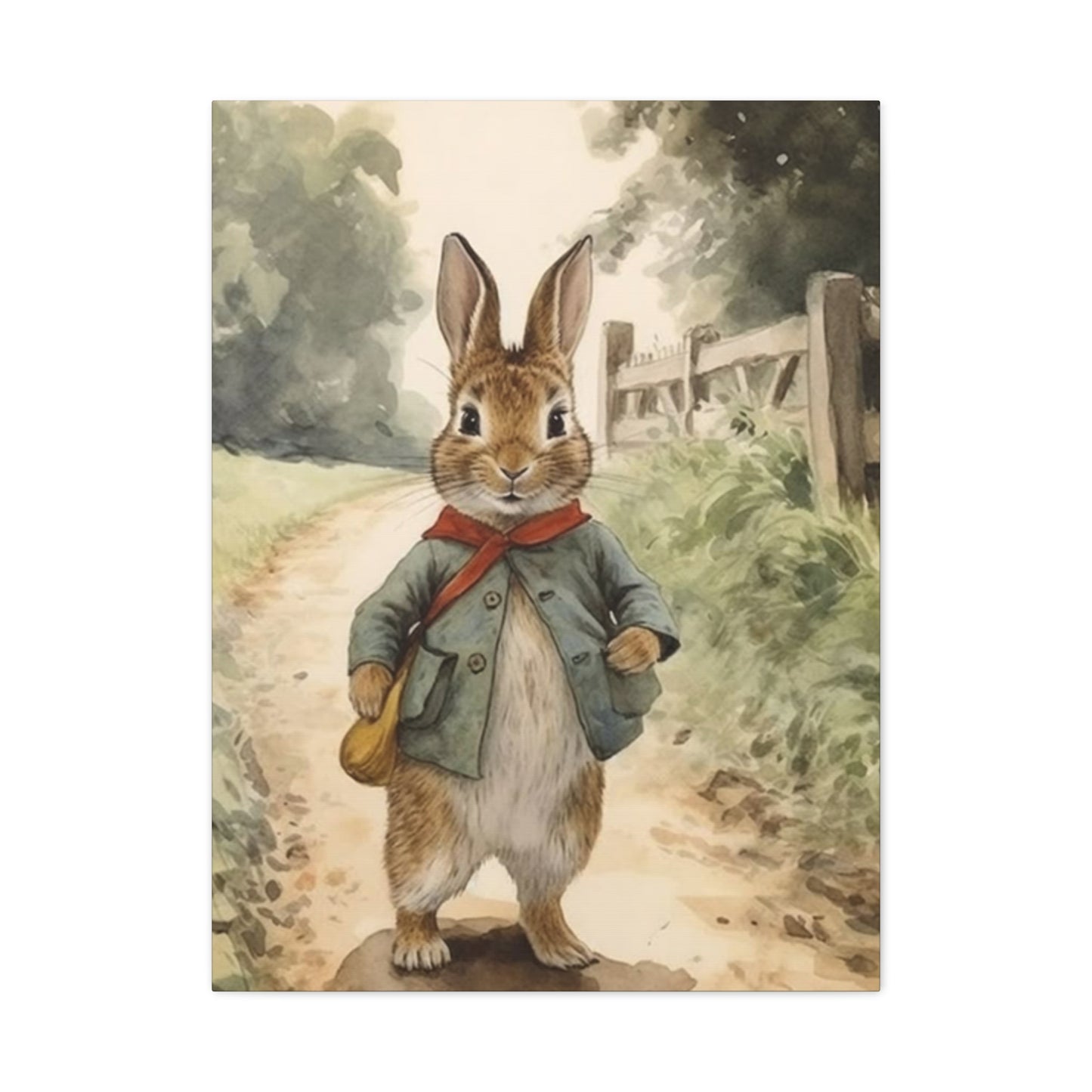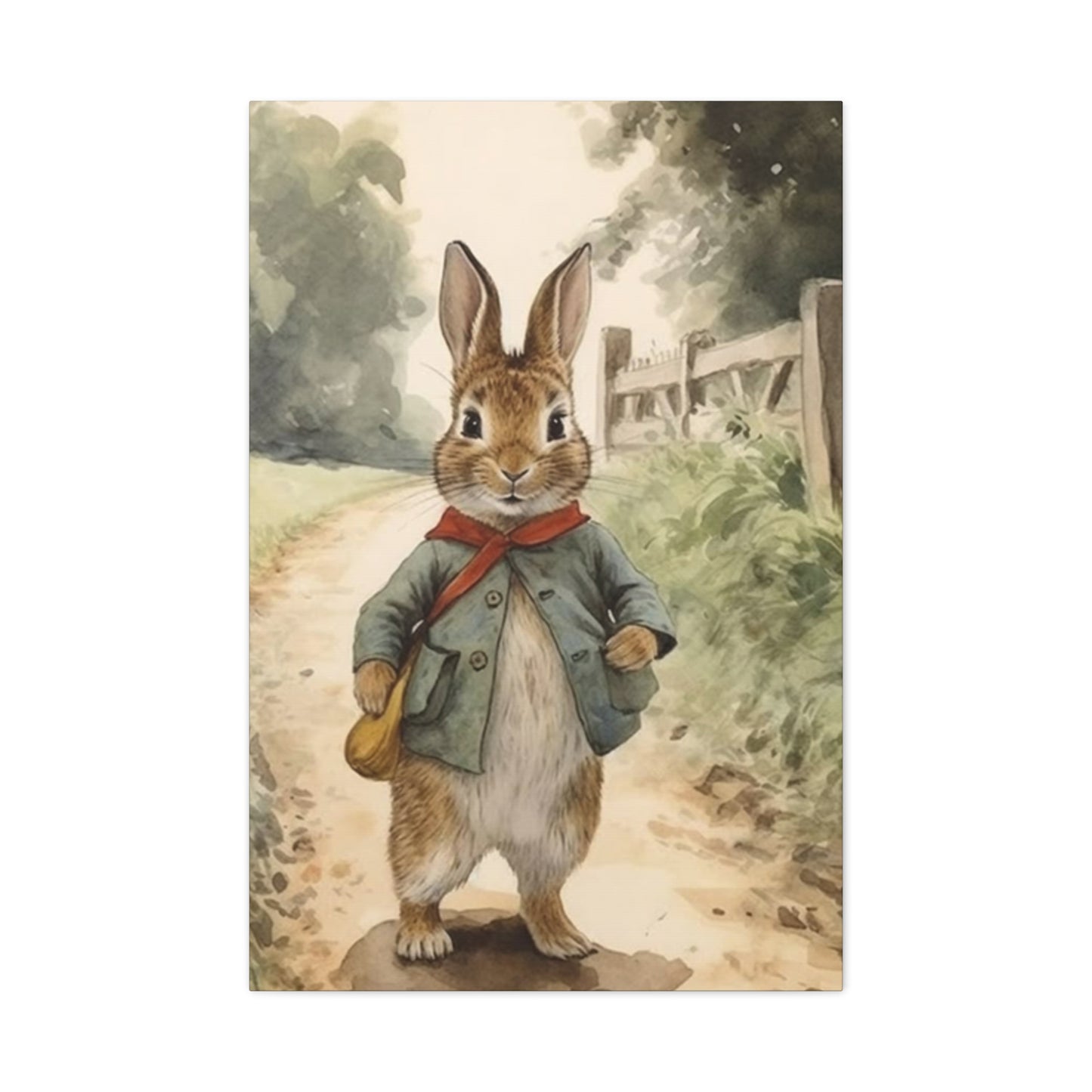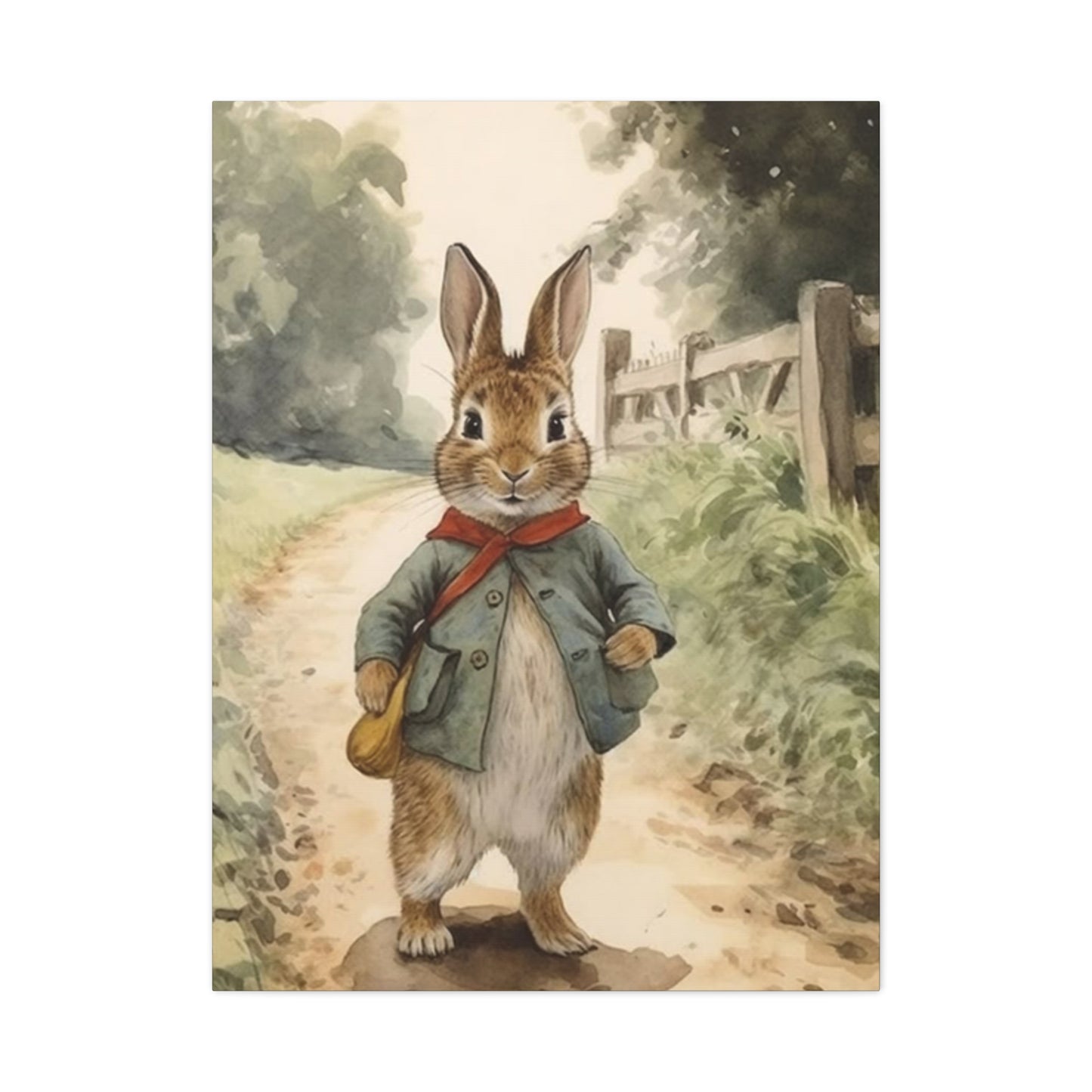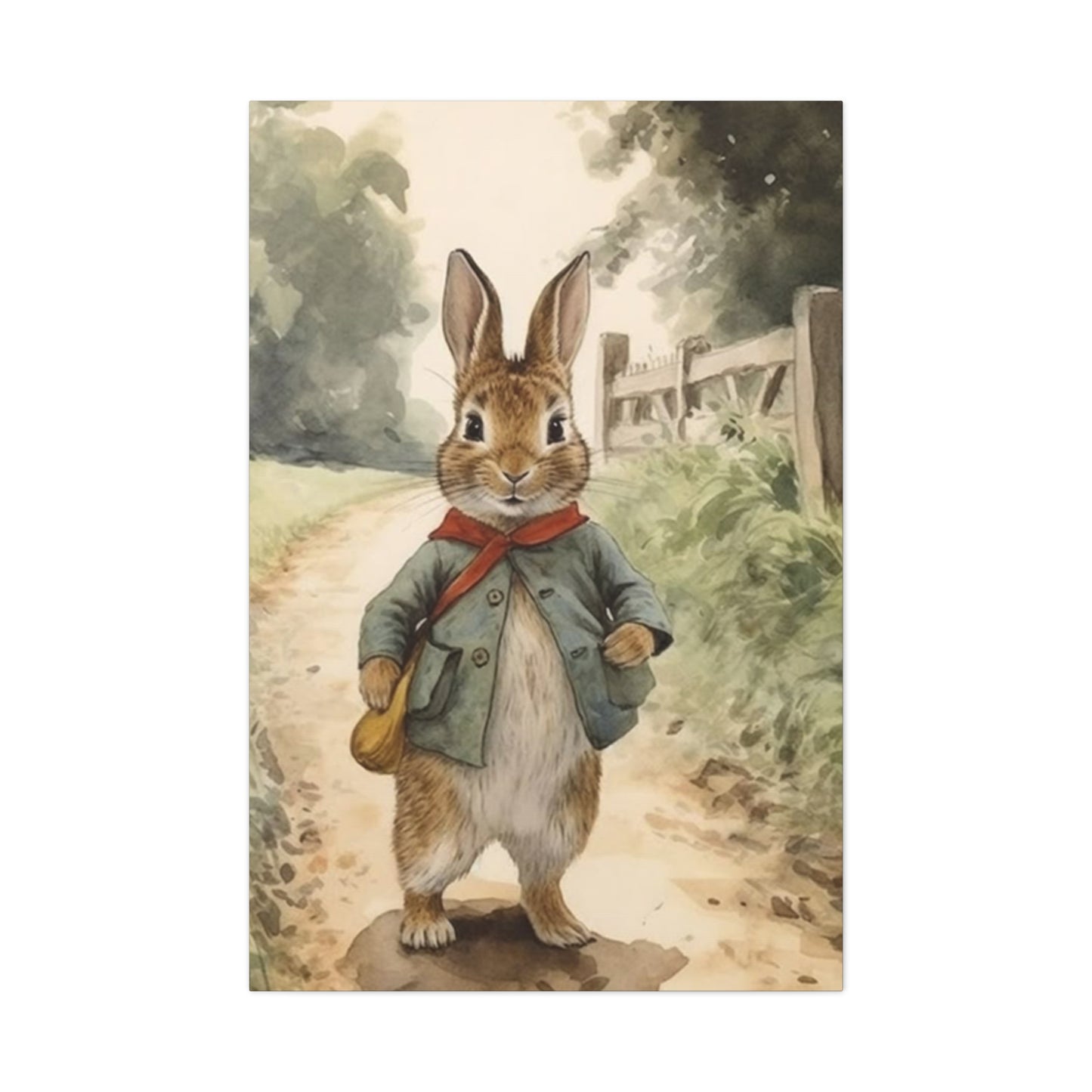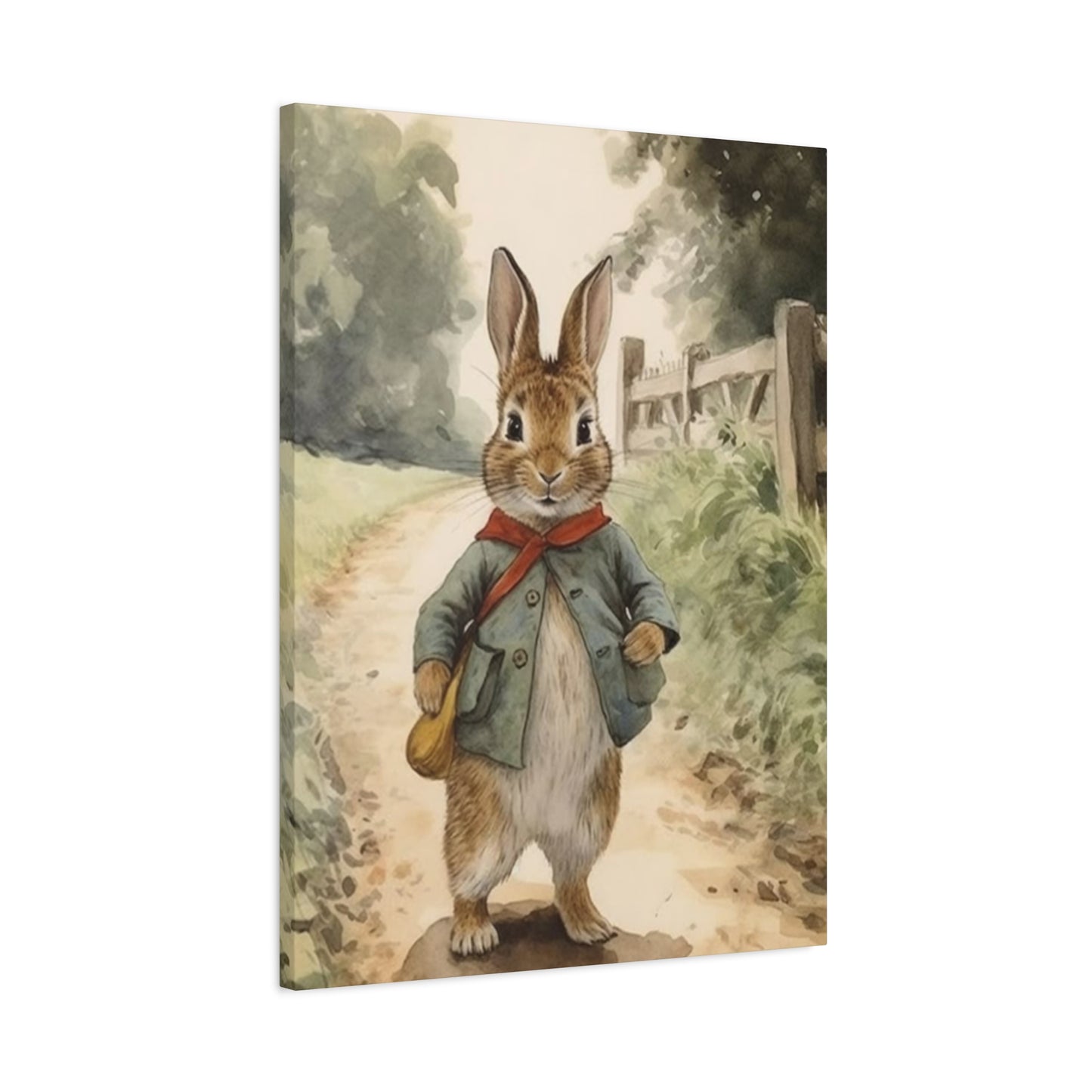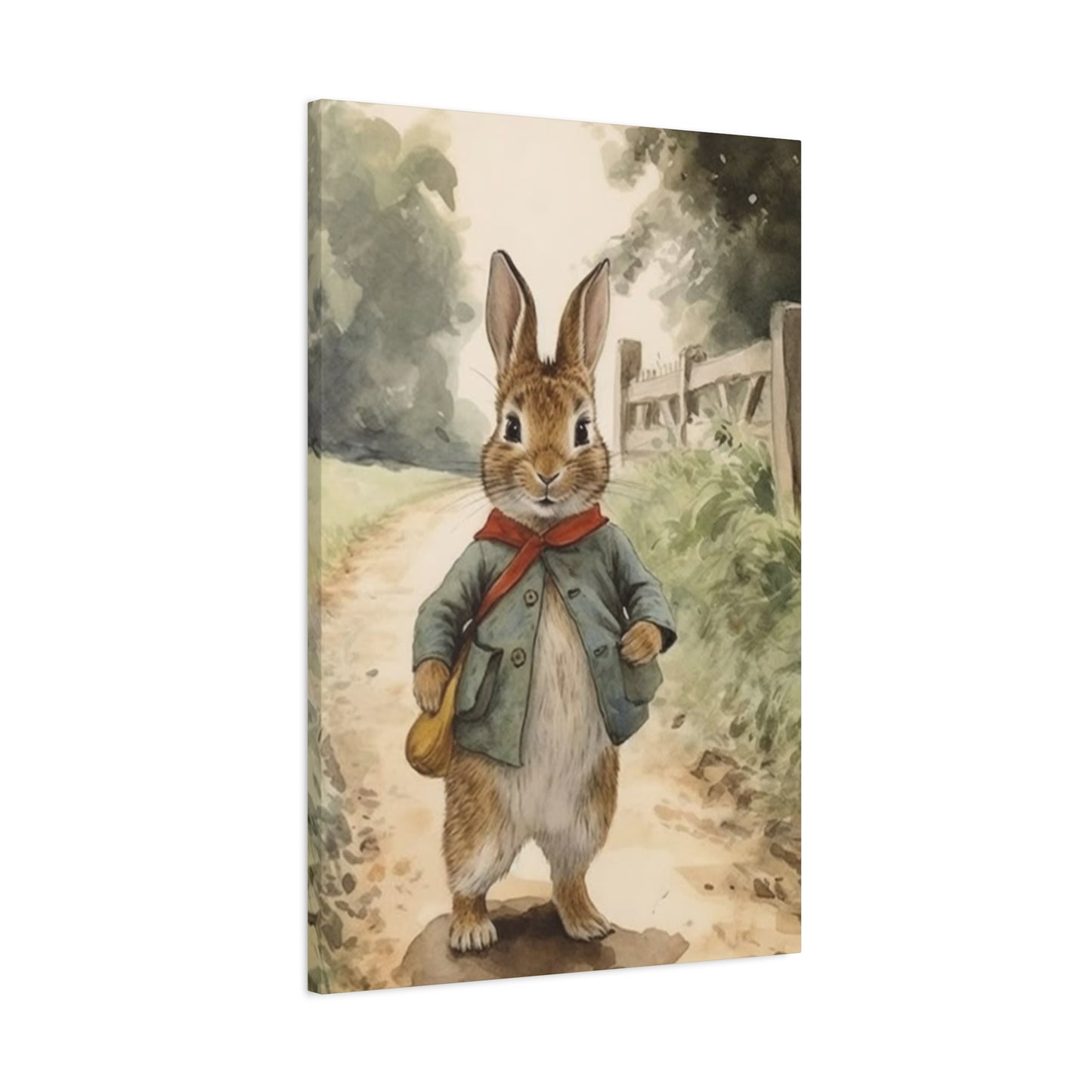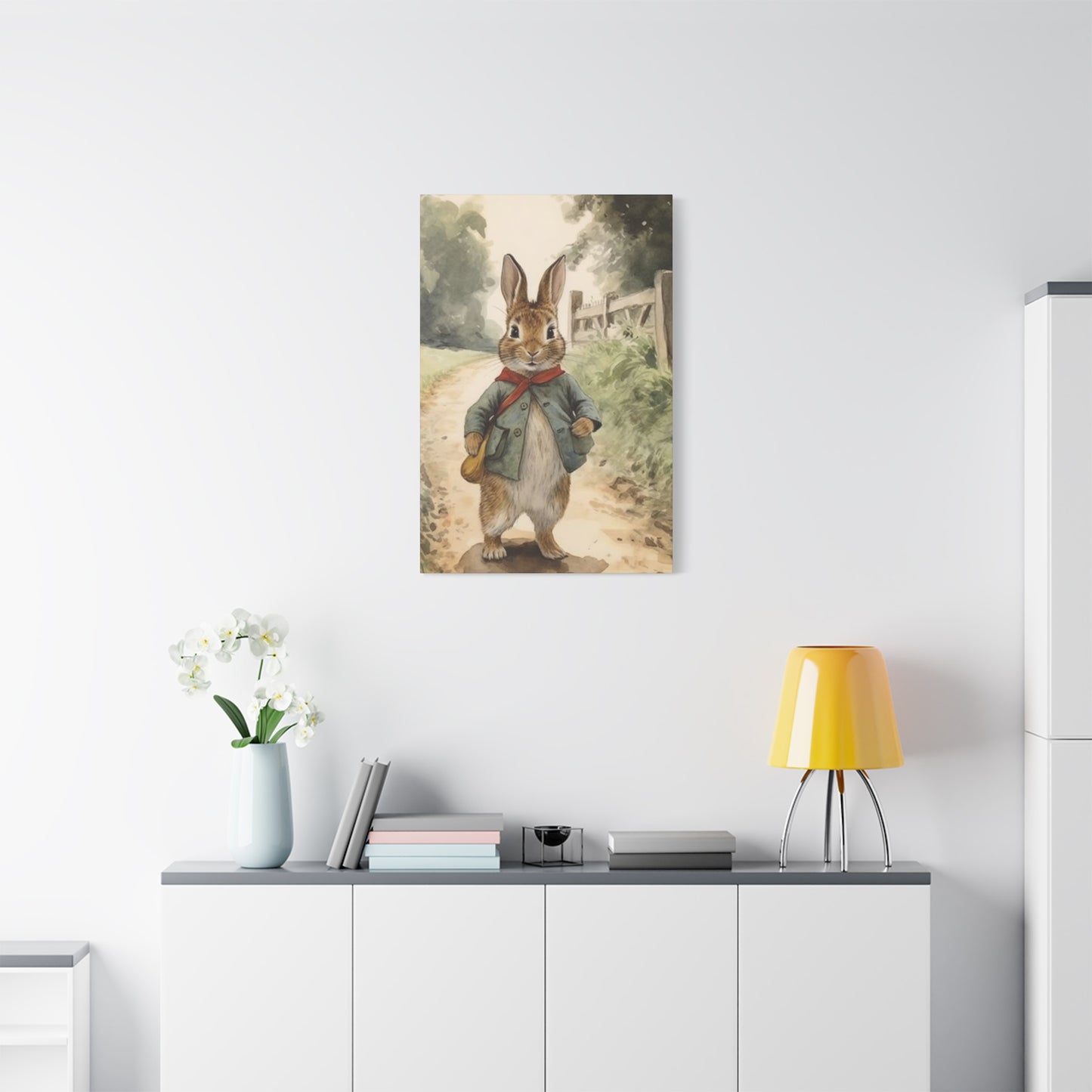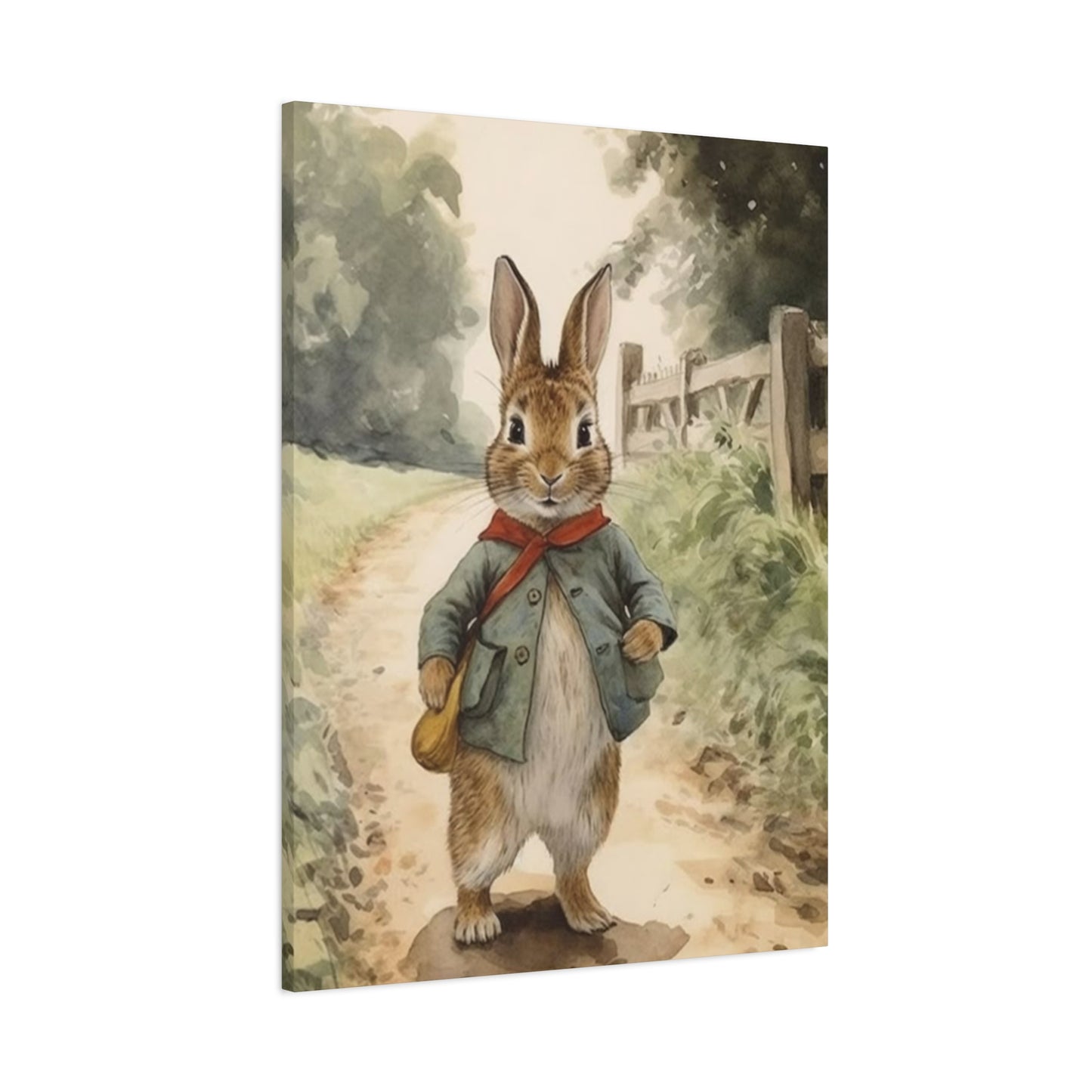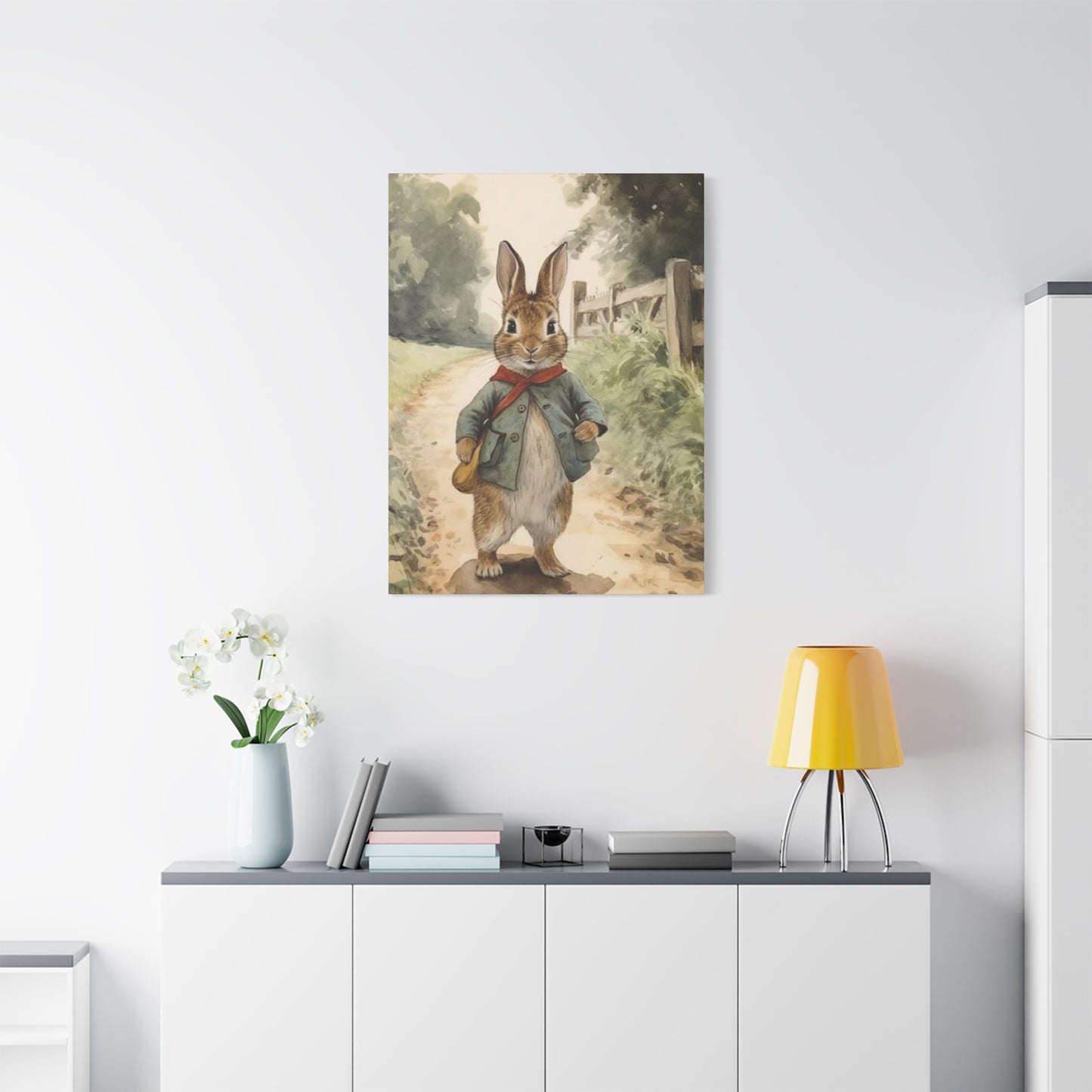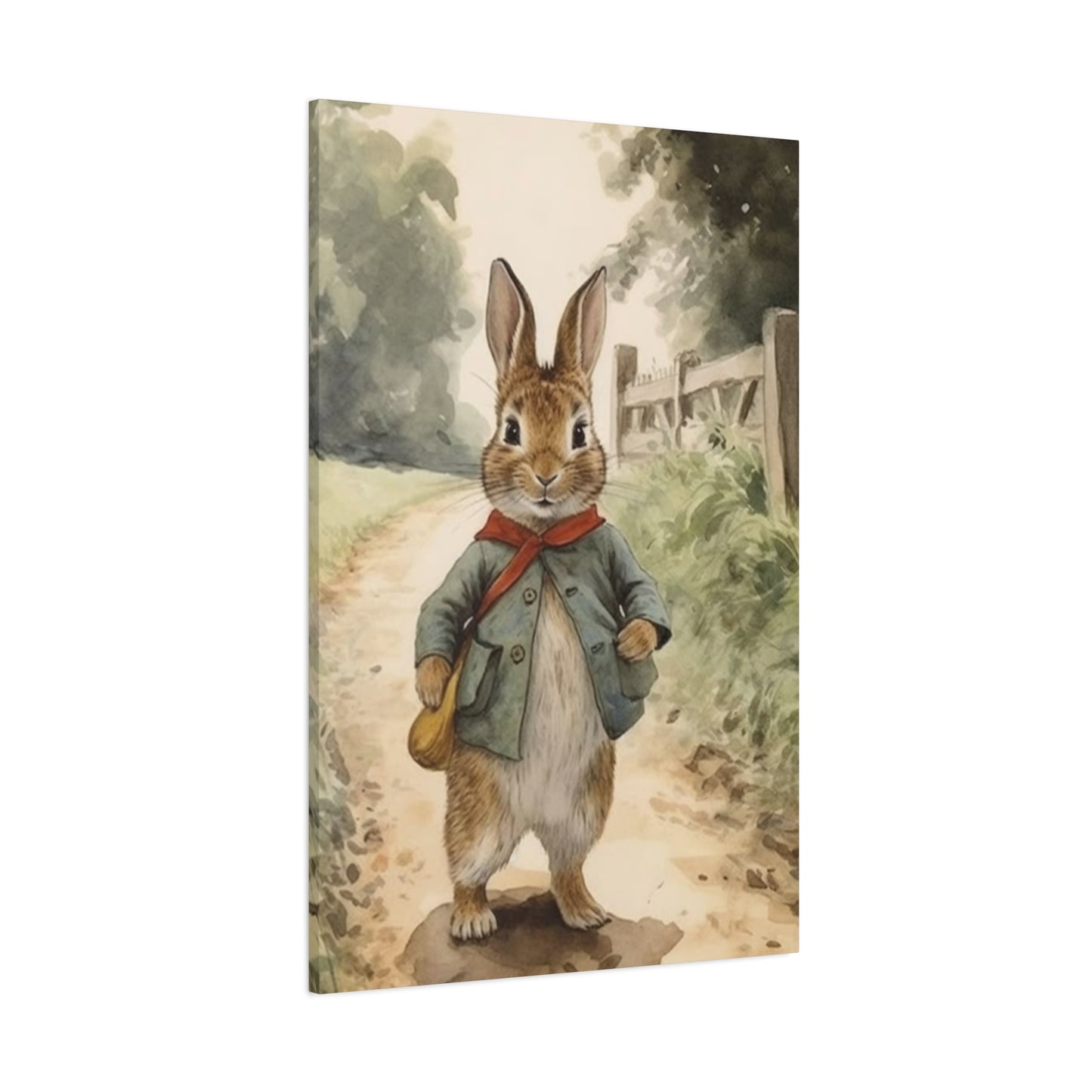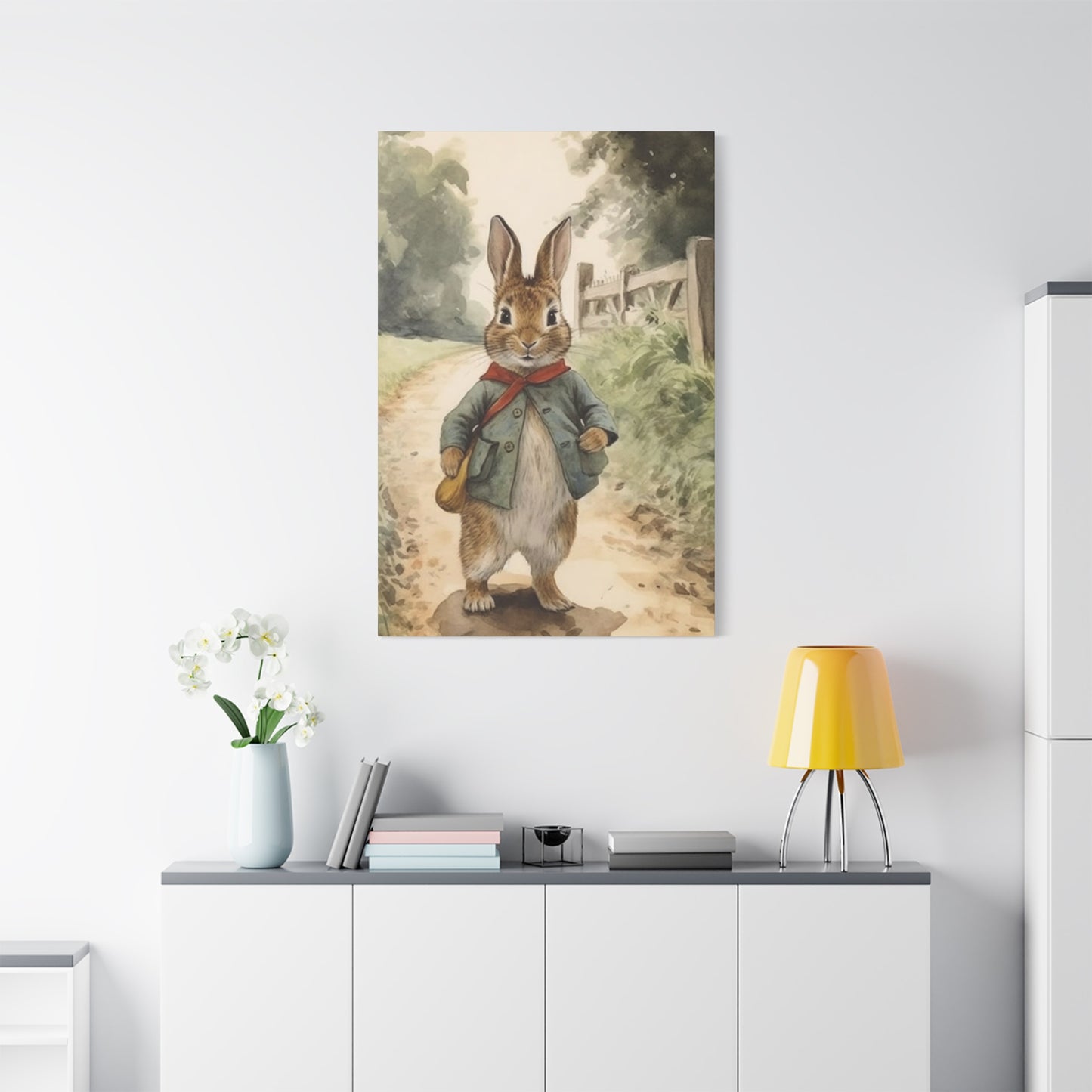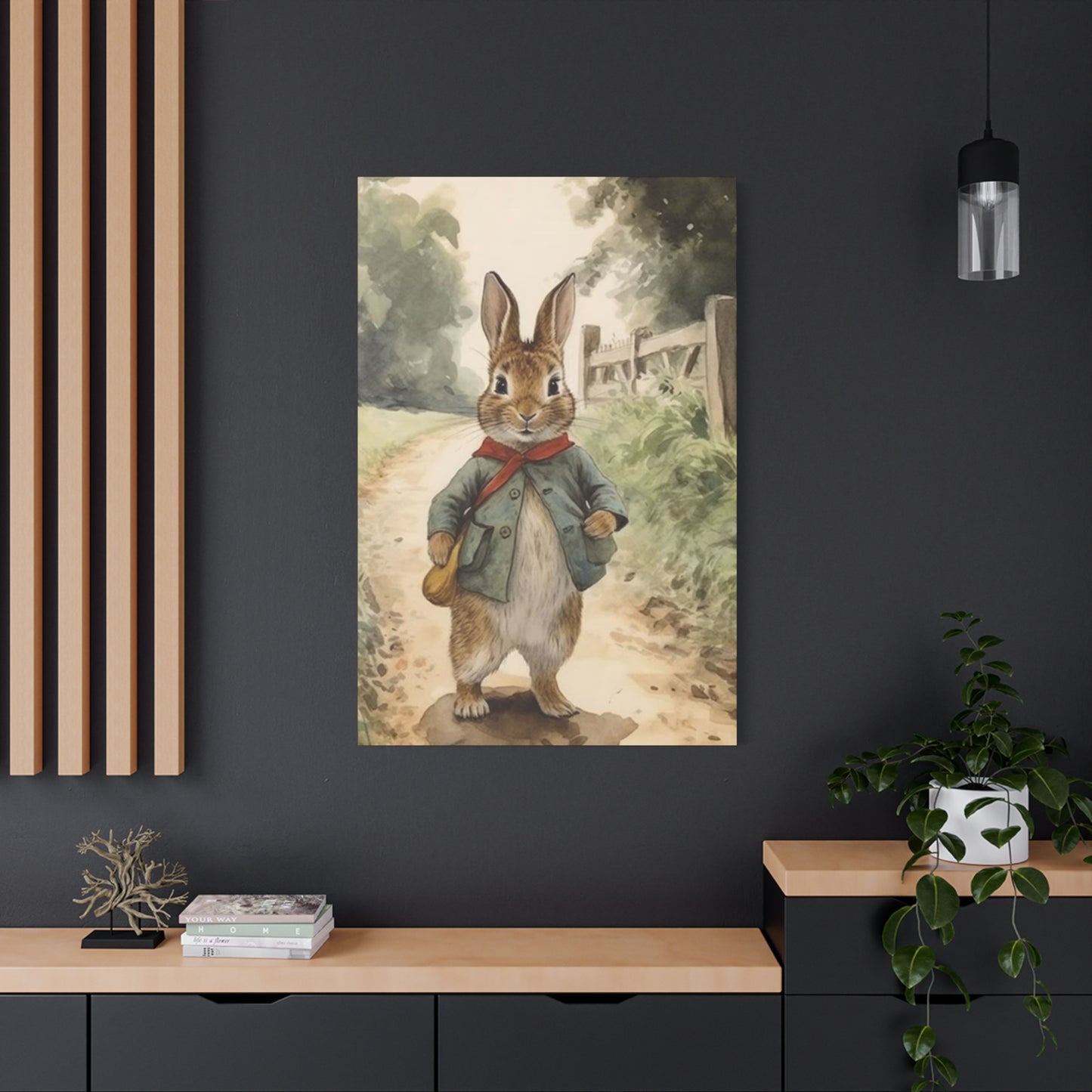The Charm of Brown Rabbit Poster Wall Art: A Symbol of Nature and Tranquility
Decorating living spaces with animal-themed artwork has become increasingly popular among homeowners and interior designers seeking to bring natural elements indoors. Among the most charming options available, brown rabbit poster wall art and canvas prints stand out as versatile decorative pieces that add warmth, personality, and a touch of nature to any room. These artistic representations of rabbits capture the gentle spirit of these beloved creatures while serving as focal points in various interior design schemes.
The appeal of rabbit-themed wall art extends beyond mere decoration. These pieces evoke feelings of comfort, innocence, and connection to the natural world. Whether displayed in nurseries, living rooms, bedrooms, or offices, brown rabbit canvas prints offer aesthetic value while creating conversation starters and expressing personal style preferences. The neutral brown tones make these artworks particularly adaptable to different color schemes and design philosophies.
This exploration of brown rabbit poster wall art examines the multifaceted aspects of incorporating such pieces into interior spaces. From understanding the artistic techniques used in creating these prints to exploring placement strategies and maintenance practices, this discussion provides valuable insights for anyone considering adding rabbit-themed artwork to their environment. The versatility of these decorative elements makes them suitable for traditional, contemporary, rustic, and eclectic design approaches.
The growing market for nature-inspired wall art reflects a broader cultural shift toward biophilic design principles, which emphasize the importance of maintaining connections with nature in built environments. Brown rabbit canvas prints exemplify this trend by bringing wildlife imagery into indoor spaces in an accessible, affordable manner. As people spend more time indoors, the psychological benefits of surrounding ourselves with nature-inspired imagery become increasingly relevant and valued.
Artistic Styles in Rabbit Canvas Prints
The world of rabbit-themed wall art encompasses numerous artistic styles, each offering distinct visual characteristics and emotional resonance. Realistic portrayals capture the intricate details of rabbit anatomy, including the texture of fur, the depth of eyes, and the subtle variations in brown coloring that occur naturally. These photographic or hyperrealistic paintings appeal to nature enthusiasts who appreciate accurate representations of wildlife.
Watercolor interpretations of brown rabbits provide softer, more ethereal aesthetics. The fluid nature of watercolor medium creates gentle transitions between shades of brown, often incorporating cream, tan, and chocolate hues that blend seamlessly. These artistic renditions tend to evoke dreamy, nostalgic feelings and work particularly well in spaces designed for relaxation and contemplation. The translucent qualities of watercolor give rabbit artwork an airy, lightweight appearance.
Minimalist rabbit designs strip away excessive detail to focus on essential shapes and forms. These simplified representations often use solid brown silhouettes or basic line drawings that capture the recognizable profile of rabbits without elaborate embellishment. Such minimalist approaches suit modern and contemporary interiors where clean lines and uncluttered aesthetics prevail. The simplicity allows these pieces to complement rather than dominate their surroundings.
Vintage and retro-inspired rabbit artwork draws from historical illustration traditions, often featuring muted brown tones reminiscent of aged photographs or classic storybook illustrations. These nostalgic pieces evoke childhood memories and simpler times, making them popular choices for nurseries and family spaces. The deliberately aged appearance adds character and warmth to interiors seeking a lived-in, comfortable atmosphere.
Abstract interpretations push creative boundaries by representing rabbits through unconventional forms, colors, and compositions. While maintaining brown as a dominant color, these artistic explorations might fragment the rabbit form, use geometric shapes, or employ surrealist techniques. Abstract rabbit art appeals to adventurous decorators who value artistic expression and unique statement pieces that challenge conventional representation.
Folk art traditions from various cultures offer distinctive approaches to depicting rabbits. These styles incorporate cultural symbolism, traditional color palettes, and characteristic techniques passed through generations. Folk art rabbit prints bring cultural richness and storytelling elements into interior spaces, connecting modern homes with artistic heritage and traditional craftsmanship values.
Color Coordination with Brown Rabbit Art
Successfully integrating brown rabbit canvas prints into existing color schemes requires understanding color theory principles and how various hues interact with the browns featured in rabbit imagery. Neutral color palettes consisting of whites, creams, grays, and blacks provide ideal backgrounds for brown rabbit artwork, allowing the prints to command attention without color competition. These neutral foundations create sophisticated, timeless environments where rabbit art becomes the primary color interest.
Earth tone combinations featuring browns, tans, terracottas, and olive greens create harmonious relationships with brown rabbit prints. This monochromatic approach emphasizes natural, organic aesthetics that reinforce the wildlife theme of rabbit imagery. Layering different brown shades throughout textiles, furniture, and accessories builds depth while maintaining cohesive color stories that feel grounded and connected to nature.
Contrasting color approaches pair brown rabbit artwork with complementary hues that appear opposite on color wheels. Blues and blue-greens create striking juxtapositions with brown tones, providing visual energy and preventing spaces from feeling monotonous. Soft powder blues paired with chocolate brown rabbits evoke countryside charm, while deeper navy contrasts create more dramatic, sophisticated aesthetics.
Pastel color schemes incorporating pinks, lavenders, mint greens, and pale yellows work beautifully with brown rabbit prints, especially in nurseries and bedrooms. The gentle warmth of brown rabbit imagery balances the coolness of pastel hues, preventing spaces from feeling too saccharine or one-dimensional. This combination creates soothing, nurturing environments appropriate for rest and childhood development.
Warm color palettes featuring reds, oranges, and yellows can accommodate brown rabbit artwork when carefully balanced. The key involves selecting muted, earthy versions of warm colors rather than bright, saturated alternatives that might overwhelm the subtlety of brown rabbit prints. Burnt orange, rust, and golden yellow create autumnal atmospheres that complement rather than compete with brown wildlife imagery.
Monochromatic brown schemes offer opportunities to explore the full range of brown variations from lightest tan to deepest chocolate. Within these environments, brown rabbit canvas prints contribute to sophisticated, layered designs that demonstrate how single color families contain remarkable diversity. This approach suits mature, elegant spaces where subtlety and refinement take precedence over bold color statements.
Lighting Techniques for Canvas Displays
Proper lighting dramatically enhances the visual impact of brown rabbit canvas prints while protecting these investments from premature deterioration. Natural light considerations involve balancing the desire for daylight illumination against the damaging effects of ultraviolet radiation on canvas and inks. Positioning rabbit artwork perpendicular to windows rather than directly opposite them reduces direct sun exposure while allowing ambient natural light to illuminate the prints.
Picture lights mounted directly above canvas prints provide focused illumination that highlights artwork while creating gallery-like presentations. For brown rabbit prints, warm-toned LED picture lights enhance the natural warmth of brown pigments without introducing color distortion. Adjustable picture lights allow fine-tuning of beam angles and intensity to achieve optimal visual effects for specific artworks and viewing distances.
Track lighting systems offer flexibility in illuminating multiple artworks or adjusting spotlight positions as decor evolves. When lighting brown rabbit canvas prints with track systems, positioning lights at approximately thirty-degree angles prevents glare while evenly distributing illumination across the artwork surface. Dimmable track lights provide control over ambiance, allowing adjustment between bright daytime display and subtle evening mood lighting.
Accent lighting strategies use brown rabbit artwork as focal points within broader room lighting designs. By illuminating rabbit prints more brightly than surrounding walls, these pieces naturally draw attention and establish visual hierarchy. This technique proves particularly effective in large rooms where multiple design elements compete for attention, allowing rabbit artwork to anchor specific areas or zones.
Ambient lighting approaches integrate brown rabbit canvas prints into overall room illumination schemes without spotlight emphasis. This subtler strategy suits spaces where artwork contributes to atmosphere without demanding primary focus. Recessed ceiling lights, wall sconces, and floor lamps provide general illumination that reveals rabbit prints as integral design elements rather than isolated display pieces.
Avoiding common lighting mistakes preserves both the appearance and longevity of brown rabbit artwork. Halogen bulbs generate excessive heat that can damage canvas and accelerate ink fading, making LED alternatives preferable for all artwork lighting applications. Extremely bright or harsh lighting washes out the subtle tonal variations in brown rabbit prints, diminishing their visual depth and artistic qualities. Consulting lighting professionals for valuable artwork ensures appropriate fixture selection and positioning.
Cultural Symbolism of Rabbits
Rabbits hold diverse symbolic meanings across global cultures, adding layers of significance to brown rabbit canvas prints beyond their aesthetic appeal. In Chinese culture, rabbits represent the moon, longevity, and good fortune, with particularly strong associations with the Mid-Autumn Festival. The Jade Rabbit legend, which tells of a rabbit companion to the moon goddess Chang'e, makes rabbit imagery auspicious in Chinese homes and spaces seeking to invite positive energy.
European folklore traditions frequently feature rabbits as clever trickster figures who use wit to overcome larger, more powerful adversaries. These narrative traditions imbue rabbit imagery with connotations of intelligence, resourcefulness, and survival against odds. Brown rabbit artwork in European-influenced interiors may subconsciously evoke these cultural stories, adding narrative depth to decorative choices.
Native American traditions across various tribes assign different meanings to rabbits, often emphasizing their connection to fertility, abundance, and the cyclical nature of life. Some traditions view rabbits as messengers or teachers, while others associate them with fear and vulnerability requiring protective courage. These diverse interpretations remind us that rabbit symbolism varies significantly even within broad cultural categories.
Japanese culture celebrates rabbits through various artistic and cultural expressions, including the famous moon-gazing rabbits of folklore and the lucky rabbit's foot tradition adapted from Western influences. Rabbit imagery appears frequently in Japanese textiles, ceramics, and paintings, often representing good fortune and clever thinking. Brown rabbit canvas prints in spaces influenced by Japanese aesthetics connect with these cultural traditions.
Celtic mythology includes rabbit symbolism associated with the goddess Eostre, from whom the word Easter derives. This connection links rabbits with spring, renewal, and rebirth themes that transcend specific religious contexts to represent universal experiences of seasonal change and new beginnings. Brown rabbit artwork can symbolically invite these regenerative energies into living spaces.
Contemporary popular culture has further shaped rabbit symbolism through beloved characters in literature, film, and animation. From Beatrix Potter's Peter Rabbit to the various rabbits in Alice's Adventures in Wonderland, these cultural references influence how modern viewers interpret rabbit imagery. Brown rabbit prints may evoke these fictional associations, connecting artwork with cherished stories and childhood memories.
Seasonal Decorating with Rabbit Art
Brown rabbit canvas prints demonstrate remarkable versatility across seasonal decorating schemes, adapting to changing aesthetic preferences throughout the year. Spring decorating naturally embraces rabbit imagery given cultural associations with Easter and renewal. Pairing brown rabbit artwork with fresh flowers, pastel accessories, and lightweight textiles creates cohesive spring environments that celebrate the season's themes of growth and new beginnings.
Summer adaptations involve surrounding brown rabbit prints with brighter, more vibrant accent colors that reflect the season's energy. Incorporating botanical elements, natural fiber textures, and open, airy arrangements allows rabbit artwork to contribute to breezy summer aesthetics. The earth tones of brown rabbits provide grounding elements that prevent summer decor from feeling overly chaotic or visually overwhelming.
Autumn represents the most natural seasonal fit for brown rabbit canvas prints, as the artwork's warm brown tones harmonize perfectly with fall color palettes. Combining rabbit prints with russet, gold, and deep green accessories creates rich, layered autumn environments. Adding seasonal elements like pinecones, dried leaves, and harvest-themed textiles reinforces connections between rabbit imagery and natural cycles.
Winter decorating approaches can incorporate brown rabbit artwork by emphasizing cozy, hibernation-inspired themes. Pairing rabbit prints with chunky knit textiles, warm lighting, and rich wood tones creates inviting winter retreats. While rabbit imagery might seem less obvious for winter decor than spring, the animals' endurance through harsh seasons makes them symbolically appropriate for cold-weather environments.
Holiday-specific decorating allows temporary enhancement of brown rabbit canvas prints without permanent alterations. Simple additions like garlands draped near rabbit artwork, seasonal wreaths positioned adjacently, or coordinating pillow covers on nearby furniture create festive connections. These temporary modifications allow rabbit prints to participate in holiday celebrations while maintaining their year-round presence.
Transitional decorating between seasons leverages the neutral brown tones of rabbit artwork as constants while changing surrounding elements. This approach reduces decorating effort and expense by keeping core pieces like rabbit canvas prints in place while rotating smaller, more affordable accessories. The stability of rabbit artwork provides visual continuity even as seasonal palettes shift dramatically.
Combining Rabbit Art with Other Decor
Successfully integrating brown rabbit canvas prints into broader decorative schemes requires thoughtful coordination with other design elements, textiles, and accessories. Pairing rabbit artwork with botanical prints or nature photography creates cohesive natural themes that reinforce connections with the outdoor world. These combinations work particularly well in rooms designed as nature-inspired retreats or spaces emphasizing organic, earth-friendly values.
Textile coordination involves selecting fabrics for pillows, throws, curtains, and upholstery that complement the brown tones in rabbit artwork. Patterns featuring similar earth tones, nature motifs, or texture variations create visual relationships between soft goods and wall art. Velvet, linen, and wool textiles introduce tactile dimension that parallels the visual softness of rabbit imagery.
Furniture placement in relation to brown rabbit canvas prints affects how effectively these pieces integrate into overall room designs. Positioning seating to face rabbit artwork encourages viewing and appreciation, making the prints functional focal points. Alternatively, placing rabbit art above furniture used while facing away, such as desks or dining chairs, provides pleasant views for room observers even when furniture occupants face different directions.
Accessory selection including vases, sculptures, books, and decorative objects can echo themes established by brown rabbit prints. Actual rabbit figurines might risk appearing too literal, but organic shapes, natural materials, and earth-toned accessories create subtle thematic connections. Balancing themed accessories prevents spaces from feeling overly coordinated or costume-like while maintaining design coherence.
Lighting fixtures contribute significantly to how brown rabbit artwork appears and integrates into spaces. Pendant lights, table lamps, and floor lamps in materials and colors that complement rabbit prints create unified lighting narratives. Natural materials like wood, stone, and woven fibers in lighting design reinforce the organic qualities suggested by rabbit imagery.
Architectural features including built-in shelving, fireplace surrounds, and moldings interact with brown rabbit canvas prints to either enhance or detract from their impact. Positioning rabbit artwork to align with architectural elements creates ordered, intentional appearances, while deliberately asymmetrical placements can generate more dynamic, casual energy. Understanding existing architectural rhythms guides optimal artwork positioning decisions.
Creating Gallery Walls with Rabbit Prints
Gallery wall installations featuring brown rabbit canvas prints alongside complementary artworks create visually rich displays that tell stories and express personal style comprehensively. The foundational decision involves determining whether gallery walls should feature exclusively rabbit-themed works or incorporate rabbit prints within diverse artistic subjects. Exclusively rabbit-focused galleries create strong thematic statements, while mixed galleries allow rabbit art to contribute without dominating.
Layout planning for gallery walls requires careful attention to spacing, visual weight distribution, and compositional balance. Beginning with the largest brown rabbit canvas print as an anchor piece provides a reference point around which smaller works arrange. Maintaining consistent spacing between all pieces, typically two to three inches, creates unified appearances despite varying artwork sizes and subjects.
Color coordination within gallery walls ensures cohesive appearances even when combining different artistic styles and subjects. Brown rabbit prints with their neutral earth tones serve as excellent anchoring pieces around which more colorful works can orbit. Repeating the brown tones from rabbit artwork in other gallery pieces through frames, mats, or color elements creates visual threads that unify diverse artworks.
Frame consistency decisions significantly impact gallery wall aesthetics, with options ranging from uniform frames across all pieces to deliberately eclectic mixing. For gallery walls featuring brown rabbit prints, using consistent frames creates formal, organized appearances, while mixing frame styles generates more casual, collected-over-time feelings. Either approach works when executed intentionally rather than accidentally.
Template creation before hanging gallery walls prevents unnecessary wall damage and ensures satisfactory arrangements. Cutting paper templates matching each artwork's dimensions and temporarily arranging these on floors or taping them to walls allows experimentation without commitment. Once satisfied with arrangements, templates guide precise hanging positions, ensuring gallery walls match planning visions.
Thematic storytelling through gallery walls transforms random artwork collections into narratives. Brown rabbit prints might anchor nature-themed galleries incorporating botanical studies, landscape paintings, and wildlife photography. Alternatively, rabbit artwork could represent childhood themes within galleries featuring vintage toys, children's book illustrations, and nostalgic objects, creating emotionally resonant displays.
Nursery and Children's Room Applications
Brown rabbit canvas prints serve multiple functions in nurseries and children's rooms, providing decoration, educational opportunities, and emotional comfort. The gentle nature of rabbit imagery creates soothing atmospheres appropriate for infant sleep and care routines. Unlike more stimulating animals or bright colors that might disrupt rest, brown rabbits offer calming visual interest that supports rather than hinders sleep development.
Educational aspects of rabbit artwork in children's spaces include teaching animal identification, fostering nature appreciation, and encouraging artistic awareness. As children grow, parents can discuss rabbit characteristics, habitats, and behaviors prompted by bedroom artwork. These incidental learning opportunities make rabbit prints functional educational tools rather than purely decorative elements.
Age-appropriate selection of rabbit artwork styles ensures developmental appropriateness across childhood stages. Simplified, cartoonish rabbit illustrations suit younger children's visual preferences and cognitive development stages, while more realistic or artistic representations appeal to older children developing sophisticated aesthetic preferences. Transitioning artwork as children mature demonstrates respect for evolving tastes while maintaining rabbit themes if desired.
Safety considerations for artwork in children's spaces require secure mounting that prevents falling or tipping. Heavy-duty picture hangers, proper wall anchor selection, and avoiding placement above cribs or beds where falling artwork could cause injury ensure safety. Canvas prints offer advantages over framed glass artwork in children's rooms, as canvas materials present fewer injury risks if somehow dislodged.
Interactive elements can enhance brown rabbit canvas prints in children's rooms, transforming passive artwork into engagement opportunities. Positioning rabbit prints at child eye level encourages interaction, while accompanying rabbit-themed books, toys, or activities creates multimedia learning experiences. Some parents create treasure hunts or storytelling games incorporating bedroom rabbit artwork, making pieces active participants in play.
Coordinating room themes around brown rabbit canvas prints involves selecting complementary bedding, rugs, curtains, and accessories that reinforce nature or animal motifs. Woodland creature themes naturally incorporate rabbit artwork alongside foxes, owls, and deer imagery. Alternately, garden themes featuring rabbits with vegetables, flowers, and butterflies create cheerful, growth-oriented environments appropriate for childhood development.
Feng Shui and Rabbit Artwork Placement
Applying feng shui principles when positioning brown rabbit canvas prints optimizes energy flow and enhances the positive qualities associated with these nature-inspired artworks. In feng shui philosophy, rabbits represent the moon, longevity, sensitivity, and good fortune, making rabbit imagery generally auspicious for home environments. Understanding optimal placement according to feng shui principles allows decoration choices to serve both aesthetic and energetic functions.
The eastern sector of spaces governs family and health in feng shui practice, making this area particularly appropriate for brown rabbit artwork. Positioning rabbit prints in eastern wall locations symbolically invites family harmony and supports household wellbeing. The wood element associated with the east complements the natural, organic qualities of rabbit imagery, creating elemental harmony.
Bedroom placement of rabbit artwork requires special consideration in feng shui practice, as bedrooms serve as primary rest and intimacy spaces. Avoiding placement directly opposite bed footboards prevents energy from flowing too directly toward sleeping occupants. Instead, positioning brown rabbit prints on walls parallel to beds or above headboards creates more favorable energy flow patterns supporting rest and relationship harmony.
The bagua map used in feng shui space analysis identifies nine life areas corresponding to different space sectors. Brown rabbit canvas prints placed in the abundance and prosperity area, typically the southeastern space section, may symbolically support financial wellbeing. Rabbit imagery in the knowledge and wisdom sector, located northeast, could enhance learning and personal growth pursuits.
Balancing yin and yang energies involves ensuring brown rabbit artwork contributes appropriate qualities to specific spaces. The gentle, soft nature of rabbit imagery provides yin qualities suitable for areas intended for rest, reflection, and quiet activities. In spaces requiring more yang energy, such as exercise areas or creative studios, rabbit artwork should balance rather than dominate, preventing excessive yin that might reduce motivation or activity levels.
Number considerations in feng shui suggest displaying artwork in auspicious quantities. Single rabbit prints create strong focal points and unified energy. Pairs of rabbit artworks can symbolize partnership and balance, appropriate for relationship-focused bedroom spaces. Groupings of three pieces create growth energy, while larger odd-numbered arrangements maintain dynamic rather than static energy.
Biophilic Design Principles
Brown rabbit canvas prints exemplify biophilic design principles, which emphasize incorporating nature elements into built environments to support human wellbeing. Research consistently demonstrates that nature connections reduce stress, improve cognitive function, enhance creativity, and support overall physical health. Wildlife imagery like rabbit prints serves as accessible biophilic design elements in spaces where living plants or actual nature views are impractical.
Visual connections to nature, one of biophilic design's core patterns, directly benefit from artwork featuring animals like rabbits. These visual nature references trigger similar psychological responses as actual nature exposure, though typically less intense. Brown rabbit prints provide consistent nature reminders regardless of season or weather, maintaining biophilic connections year-round in climate-controlled interior environments.
Natural color palettes central to biophilic design find perfect expression in brown rabbit artwork, which features earth tones directly referencing natural materials and landscapes. These organic color schemes support circadian rhythm regulation and reduce visual stress compared with artificial color combinations lacking nature precedents. The browns in rabbit prints evoke soil, tree bark, and autumn leaves, creating subconscious nature associations.
Biophilic design patterns including refuge and prospect find support through thoughtful rabbit artwork placement. Creating intimate seating areas with views toward brown rabbit prints satisfies psychological needs for both safety and environmental awareness. These arrangements allow occupants to feel protected while maintaining visual connections with representation of living creatures, fulfilling deep evolutionary needs.
Material authenticity in biophilic design suggests using actual natural materials rather than synthetic imitations when possible. For brown rabbit canvas prints, this principle supports choosing natural cotton canvas over synthetic alternatives and wood frames over plastic. These material choices enhance biophilic effects by providing authentic nature connections through both imagery and physical materials.
Natural patterns and fractals, which appear throughout nature and support visual processing efficiency, can enhance spaces surrounding brown rabbit prints. Complementing rabbit artwork with botanical patterns, organic shapes in furniture, and fractal geometries in textiles creates layered biophilic environments where multiple nature-referencing elements work synergistically to maximize wellbeing benefits.
DIY Framing and Installation
Undertaking do-it-yourself framing projects for brown rabbit canvas prints offers cost savings and creative control, though requiring basic tools and patience. Measuring canvas dimensions accurately represents the critical first step, as frame sizing errors result in gaps or squeezing that damage artwork. Recording height, width, and depth measurements ensures proper frame selection whether purchasing ready-made options or building custom solutions.
Ready-made frame selection involves finding commercially available frames matching canvas dimensions, though perfect matches may prove elusive. Standard sizes like sixteen by twenty inches or twenty-four by thirty-six inches offer the widest frame selection, while unusual dimensions require more searching or custom solutions. Many frame retailers offer services modifying standard frames to accommodate specific measurements.
Basic framing tools including hammer, level, measuring tape, pencil, and appropriate wall anchors enable successful installation without professional assistance. Picture hanging kits available at hardware stores provide necessary hardware for various wall types. Understanding wall construction, whether drywall, plaster, brick, or concrete, guides appropriate anchor selection that safely supports canvas weight.
Gallery wall installation challenges DIY enthusiasts with multiple pieces requiring coordinated positioning. Creating paper templates representing each canvas size allows floor arrangement experimentation before wall commitment. Transferring successful arrangements to walls involves marking template positions with pencil before removing templates and installing actual hanging hardware. Laser levels help ensure horizontal alignment across multiple pieces.
Wire hanging systems offer advantages over traditional picture hooks by allowing easy height adjustment and weight distribution. Installing wire on canvas frame backs requires eye hooks positioned approximately one-third down from top edges. The wire should have slight slack rather than pulling tight, as excessive tension concentrates stress that can damage frames or pull hardware loose.
Troubleshooting common installation problems prevents frustration and wall damage. Canvases hanging crooked often result from uneven wire attachment or hardware that's not level. Pictures falling from walls typically indicate inadequate anchor strength for the weight. Regular inspection of hanging hardware ensures early detection of issues before artworks fall, particularly important for larger, heavier pieces.
Photographing Rabbit Artwork for Documentation
Properly photographing brown rabbit canvas prints documents collections for insurance purposes, creates shareable images for social media, and helps assess how artwork appears before purchase. Lighting represents the most critical factor in artwork photography, requiring even illumination without glare or hotspots. Natural indirect light from windows provides excellent illumination, though direct sun should be avoided to prevent overexposure and color distortion.
Camera positioning perpendicular to canvas surfaces prevents keystone distortion where artwork appears trapezoidal rather than rectangular. Using tripods ensures camera steadiness, eliminating blur from hand-held shooting. Positioning cameras at canvas center height maintains proper perspective, while backing away and using zoom lenses produces more flattering results than close-up wide-angle shooting.
Exposure settings balance brightness and detail capture, requiring attention to prevent blown-out highlights or crushed shadows. Many cameras offer exposure compensation allowing brightness adjustment relative to automatic settings. For brown rabbit prints, slightly underexposing by one-third to two-thirds of a stop often produces richer, more saturated browns than standard exposures that may appear washed out.
Color accuracy challenges photographers documenting artwork, as lighting color temperature significantly affects how browns reproduce. Daylight-balanced lighting around five thousand five hundred Kelvin most accurately renders brown tones, while tungsten bulbs create warm color casts and fluorescent lights often produce green tinges. Using custom white balance or shooting RAW format files allows color correction during post-processing.
Background considerations affect how brown rabbit canvas prints appear in photographs. Neutral gray or white walls provide clean backgrounds that don't compete with artwork, while busy backgrounds distract viewers and complicate color accuracy. Filling the frame primarily with artwork rather than excessive surrounding area focuses attention appropriately and maximizes image detail.
Post-processing adjustments enhance documentation photos without misrepresenting actual artwork appearance. Cropping corrects minor perspective issues and eliminates distracting background elements. Subtle adjustments to brightness, contrast, and saturation optimize digital display while maintaining accuracy to physical artwork. Avoiding heavy filtering or manipulation preserves documentary integrity, particularly important for insurance or sales purposes.
Resale Value and Collectibility
Understanding factors affecting brown rabbit canvas print resale value helps collectors make informed purchase decisions and properly care for acquisitions. Artist reputation significantly influences collectibility, with works by recognized artists commanding higher prices and appreciating more reliably than anonymous prints. Researching artist backgrounds, exhibition histories, and market presence provides insight into long-term value potential.
Limited edition prints maintain value better than unlimited reproductions, as scarcity creates demand among collectors. Numbered editions indicating print position within total production runs, such as "15/100," provide authenticity and exclusivity. Lower numbers within editions sometimes command premium prices, though overall edition size matters more than specific number placement regarding investment value.
Condition preservation directly impacts resale values, with pristine artwork commanding significant premiums over damaged pieces. Following proper care practices including appropriate lighting, climate control, and handling prevents deterioration that reduces values. Original packaging, certificates of authenticity, and purchase documentation should be retained as these materials enhance resale potential.
Provenance documentation establishing ownership history and authenticity increases collector confidence and justifies higher prices. Maintaining receipts, certificates, and correspondence related to brown rabbit artwork creates paper trails that future buyers value. For potentially valuable pieces, professional appraisals document condition and worth at specific points, providing reference for insurance and eventual sales.
Market trends in decorative art influence brown rabbit print values, with styles moving in and out of favor over time. Currently, nature-inspired and biophilic design trends support demand for wildlife artwork including rabbit prints. Monitoring interior design trends and collecting publications provides insight into whether rabbit artwork appreciation seems likely to continue or potentially decline.
Investment potential varies dramatically among brown rabbit canvas prints, from mass-produced decorative items with minimal resale value to fine art prints representing legitimate investment opportunities. Setting realistic expectations based on purchase prices, artist credentials, and edition information prevents disappointment. Most decorative rabbit prints should be purchased primarily for enjoyment rather than investment returns.
Sustainable and Ethical Sourcing
Environmentally conscious consumers increasingly prioritize sustainable sourcing when selecting brown rabbit canvas prints, considering both production methods and material origins. Canvas materials vary in environmental impact, with organic cotton representing the most sustainable option despite higher costs. Conventional cotton production uses significant pesticides and water, while polyester derives from petroleum, creating different environmental concerns.
Ink and coating selections affect environmental footprints, with water-based and vegetable-based inks offering greener alternatives to solvent-based options. These eco-friendly inks reduce volatile organic compound emissions during production and disposal while maintaining color quality and longevity. Confirming ink types requires contacting manufacturers or retailers, as this information often isn't prominently advertised.
Production location influences carbon footprints and labor practice ethics, with locally produced artwork reducing transportation emissions while supporting regional economies. Print-on-demand technologies eliminate excess inventory and waste by producing items only after purchase, though this approach may increase per-unit energy consumption compared with batch production. Balancing these competing factors requires considering personal priority hierarchies.
Certification programs including Forest Stewardship Council approval for wood frames and Fair Trade certification for imported goods provide third-party verification of sustainable and ethical practices. These certifications require meeting specific standards regarding environmental protection and labor treatment, offering consumers confidence in their purchasing decisions. However, certification costs may place these products at price disadvantages versus uncertified alternatives.
Artist compensation represents an ethical consideration, particularly regarding reproduction rights and royalty payments. Some brown rabbit prints involve properly licensed images where artists receive compensation, while others may use imagery without appropriate permissions. Supporting platforms and producers that compensate artists fairly encourages creative communities and discourages art theft.
End-of-life considerations include recyclability and disposal options for brown rabbit canvas prints when they're no longer wanted. Natural fiber canvases and wood frames biodegrade more readily than synthetic materials, though protective coatings may complicate disposal. Donation to charitable organizations, resale through second-hand marketplaces, or repurposing into craft projects extend artwork lifespans beyond initial use while reducing waste.
Digital versus Physical Canvas Prints
The emergence of digital display technologies creates new options for enjoying brown rabbit artwork through screens rather than physical prints, each approach offering distinct advantages and limitations. Physical canvas prints provide tangible presence and require no electricity, appealing to people valuing traditional artwork forms and avoiding screen proliferation. The textured surface of canvas and lack of backlight creates viewing experiences fundamentally different from digital displays.
Digital frames enable artwork rotation, displaying thousands of different images including varied brown rabbit artwork on single screens. This versatility appeals to people who tire quickly of static displays or enjoy seasonal rotation without storage concerns. However, digital frames require power, may suffer technical failures, and lack the authentic material qualities that many find appealing in traditional artwork.
Resolution considerations affect digital displays, as sufficient pixel density ensures rabbit details render clearly without pixelation. High-quality digital frames offering at least Full HD resolution provide acceptable image quality, while 4K displays deliver exceptional clarity approaching print quality. Physical canvas prints avoid resolution concerns, as high-quality printing technologies reproduce details at levels exceeding most screen capabilities.
Color reproduction differs between physical prints and digital displays, with each medium having distinct characteristics. Physical prints reflect ambient light and appear differently under various lighting conditions, while digital screens emit light and maintain more consistent appearance regardless of room lighting. Brown tones specifically may warm or cool depending on viewing conditions for prints, while digital displays maintain programmed color values.
Environmental impact comparisons reveal complex trade-offs between physical and digital artwork. Physical prints require material resources and transportation but no ongoing energy consumption, while digital frames eliminate physical materials but require continuous electricity and eventually become electronic waste. Neither option clearly dominates from environmental perspectives, as impacts depend on specific products and usage patterns.
Emotional connections and psychological responses to artwork may differ between physical and digital presentations, though research in this area remains limited. Many people report stronger emotional bonds with physical artwork they can touch and whose material presence occupies space. Digital displays may feel more temporary and less meaningful despite convenience advantages. Individual preferences vary widely, making personal experimentation the best guide.
Rabbit Symbolism in Literature and Art History
Brown rabbit imagery in contemporary canvas prints connects with rich artistic and literary traditions extending centuries into the past. Medieval illuminated manuscripts frequently featured rabbits in margin decorations, often playfully disrupting formal compositions with natural vitality. These historical precedents established rabbits as symbols of life force, nature's persistence, and the interplay between civilization and wilderness that continues resonating in modern rabbit artwork.
Renaissance art incorporated rabbit symbolism in religious and secular paintings, where rabbits often represented fertility, purity, or vulnerability. Paintings by masters like Titian and Dürer included meticulously rendered rabbits demonstrating artistic skill while contributing symbolic meanings that educated viewers would recognize. Contemporary brown rabbit prints unknowingly participate in these centuries-old symbolic traditions.
Victorian era naturalism brought renewed focus to accurate animal representation in artwork, with rabbits featured prominently in scientific illustrations and romantic pastoral scenes. This period established many visual conventions for depicting rabbits that persist in modern artwork, including characteristic poses, natural settings, and emphasis on soft fur textures. Brown rabbit canvas prints often echo Victorian aesthetic sensibilities whether intentionally or through inherited visual traditions.
Children's literature from Beatrix Potter's Peter Rabbit through contemporary publications established rabbits as beloved story characters embodying curiosity, mischief, and innocence. These literary associations influence how modern viewers interpret rabbit artwork, activating nostalgic memories and positive childhood associations. Brown rabbit prints benefit from these accumulated cultural meanings without explicitly referencing specific stories.
Modern and contemporary art movements explored rabbit imagery through various lenses, from surrealist dream sequences to pop art's elevation of popular cultural symbols. Artists like Jeff Koons with his controversial rabbit sculptures demonstrate how this familiar animal continues inspiring serious artistic investigation. Contemporary brown rabbit canvas prints exist within this ongoing artistic dialogue about meaning, representation, and human-animal relationships.
Cultural anthropology reveals rabbit symbolism varies globally, from Asian lunar associations to Native American trickster tales to European folklore traditions. This symbolic diversity enriches brown rabbit artwork with multiple possible meanings depending on cultural backgrounds viewers bring to interpretation. The accumulated weight of these traditions makes rabbit imagery remarkably potent despite superficial simplicity.
Matching Art to Architectural Styles
Successfully integrating brown rabbit canvas prints requires considering architectural context and ensuring artwork choices complement rather than contradict structural design languages. Traditional architecture featuring detailed moldings, classic proportions, and historical references accommodates rabbit artwork with corresponding traditional rendering styles. Realistic or vintage-inspired brown rabbit prints harmonize with colonial, Victorian, and craftsman architectural vocabularies.
Modern architecture emphasizing clean lines, minimal ornamentation, and geometric clarity benefits from simplified rabbit artwork with minimal detail and strong graphic qualities. Abstract or minimalist brown rabbit prints complement modern spaces without introducing visual complexity that conflicts with architectural restraint. The key involves maintaining consistency in aesthetic philosophy between architecture and artwork.
Contemporary architecture's eclectic approach allows greater flexibility in brown rabbit artwork selection, as contemporary design synthesizes diverse influences rather than adhering to specific historical styles. This architectural openness accommodates varied rabbit print styles from photorealistic to abstract, provided overall design coherence maintains through other elements like color, scale, and material consistency.
Industrial architecture featuring exposed structural elements, raw materials, and utilitarian aesthetics creates interesting tension opportunities with brown rabbit artwork. The softness and organic qualities of rabbit imagery contrast dramatically with industrial's hard edges and mechanical sensibilities, creating dynamic visual interest through opposition. Metal frames and monochromatic treatments help rabbit prints integrate more seamlessly into industrial contexts.
Rustic and farmhouse architecture naturally accommodates brown rabbit canvas prints given thematic alignment with agricultural and natural settings. These architectural styles celebrating rural life and traditional craftsmanship create ideal contexts for rabbit imagery referencing countryside and pastoral themes. Natural wood frames and slightly weathered or vintage-style prints enhance authenticity in rustic settings.
Mediterranean and Spanish colonial architecture with stucco walls, arched openings, and terra-cotta tones provides warm backdrops for brown rabbit artwork. The earth-tone palette of rabbit prints harmonizes with warm architectural colors while adding visual interest to relatively plain stucco surfaces. Wrought iron or dark wood frames bridge between rabbit artwork and Mediterranean architectural details.
Gift-Giving and Rabbit Artwork
Brown rabbit canvas prints serve as thoughtful gifts for various occasions, offering personalization possibilities and meaningful symbolism. Understanding recipient preferences regarding art styles, color schemes, and subject matter ensures gift appropriateness. Rabbit artwork's generally positive associations and widespread appeal make these prints relatively safe gift choices across diverse recipient personalities and tastes.
Housewarming gifts benefit from brown rabbit canvas prints' ability to instantly add character and warmth to new spaces. Selecting pieces sized appropriately for common wall spaces like entryways or living rooms demonstrates thoughtfulness. Including mounting hardware and perhaps professional installation gift certificates transforms rabbit prints from objects into complete gift experiences.
Baby shower and nursery gifts find natural expression in gentle brown rabbit artwork appropriate for children's spaces. Selecting prints with subtle colors and calming compositions supports infant development and creates soothing environments. Coordinating rabbit artwork with nursery themes or colors demonstrates attention to parents' decorating choices and personalizes gifts beyond generic baby items.
Wedding gifts incorporating brown rabbit canvas prints work particularly well when couples are establishing first shared homes. Pairs of rabbit prints symbolizing partnership subtly reference relationship themes without being overly sentimental. Selecting artwork that bridges different aesthetic preferences between partners demonstrates thoughtfulness about their combined tastes and future life together.
Holiday gifts during occasions like Christmas or Hanukkah can include brown rabbit artwork when recipients have expressed interest in nature themes or specific decor needs. Presenting prints attractively wrapped with perhaps fabric ribbons or natural embellishments elevates presentation and demonstrates gift-giving care. Including gift receipts allows exchanges if sizing or style doesn't suit recipient spaces perfectly.
Congratulatory gifts for achievements like graduations, promotions, or milestone birthdays can incorporate brown rabbit artwork when selected thoughtfully relative to recipient personalities and life stages. Office-appropriate rabbit prints might celebrate professional advancement, while pieces suitable for recently purchased homes acknowledge life transitions. Personalizing artwork selection to specific circumstances transforms generic gifts into meaningful commemorations.
Caring for High-Value Rabbit Prints
Collectors of valuable brown rabbit artwork require specialized knowledge about preservation, insurance, and valuation beyond routine decorative print maintenance. Professional appraisals establish baseline values and document condition through detailed descriptions and photographs. Periodic reappraisals every three to five years track value changes and ensure adequate insurance coverage as artwork appreciates or market conditions shift.
Museum-quality framing protects valuable rabbit prints while enabling viewing and enjoyment. Conservation framing uses acid-free materials, UV-filtering glazing, and reversible mounting techniques that prevent artwork damage over time. While expensive, conservation framing represents worthwhile investment for prints with significant monetary or sentimental value, dramatically extending longevity and maintaining condition.
Climate control becomes critical for valuable artwork, requiring stable temperature and humidity within narrow ranges. Fluctuations cause expansion and contraction cycles that stress canvas and printed surfaces, accelerating deterioration. Dedicated climate control in rooms housing valuable rabbit prints may be necessary, particularly in regions with extreme seasonal variations or high humidity levels.
Security considerations protect valuable brown rabbit artwork from theft through appropriate home security systems, artwork documentation, and discreet display practices. Photographing prints, recording serial numbers or edition information, and maintaining provenance documentation assists recovery if theft occurs. Avoiding social media posts showcasing valuable artwork locations prevents providing intelligence to potential thieves.
Insurance specifically covering fine art protects financial investments in valuable brown rabbit prints beyond standard homeowners policies. Specialized art insurance offers agreed-value coverage, worldwide protection during transport, and restoration coverage following damage. Providing insurers with appraisals, provenance documentation, and condition reports facilitates claims and ensures adequate compensation if losses occur.
Conservation consultation provides expert guidance when valuable rabbit artwork requires cleaning, restoration, or stabilization. Professional conservators possess specialized training in art materials, degradation mechanisms, and appropriate intervention techniques. Their expertise prevents well-intentioned but damaging amateur restoration attempts that can catastrophically reduce artwork values.
Creating Custom Rabbit Artwork
Commissioning custom brown rabbit canvas prints allows perfect personalization matching specific requirements regarding size, style, subject matter, and color. Finding appropriate artists involves researching portfolios, reviewing previous work, and ensuring artistic styles align with project visions. Online platforms connecting artists with clients, local art cooperatives, and university art departments provide starting points for identifying potential commission artists.
Commission discussions should clearly communicate expectations regarding dimensions, framing preferences, color palettes, stylistic approaches, and subject specifics. Reference images showing desired rabbit poses, artistic styles, or color schemes help artists understand visions even when requesters lack artistic vocabulary. Written agreements documenting deliverables, timelines, revision allowances, and payment terms protect both parties and prevent misunderstandings.
Pricing custom artwork depends on artist experience, piece size, medium complexity, and timeline requirements. Emerging artists charge significantly less than established professionals, though experience differences affect outcomes. Rush timelines command premium pricing, while flexible deadlines may offer cost savings. Discussing budget parameters upfront prevents wasted time pursuing commissions beyond financial means.
Revision processes during commission development allow course corrections ensuring final pieces meet expectations. Most artists include limited revisions within base pricing, with additional changes incurring extra fees. Providing constructive feedback at sketch or underpainting stages proves more efficient than requesting major changes to completed works. Maintaining respectful, collaborative relationships with artists produces better outcomes.
Copyright considerations require clarity regarding reproduction rights and future image use. Standard commission agreements grant commissioners physical artworks but artists retain copyrights, controlling reproduction and commercial use. Purchasing reproduction rights costs additional money but enables printing merchandise or using images in commercial contexts. Understanding intellectual property basics prevents legal complications.
Displaying custom rabbit artwork merits premium presentation reflecting the investment and personal significance. Professional framing, prominent positioning, and appropriate lighting honor commissioned pieces and maximize enjoyment. Custom artwork becomes heirloom-quality items potentially appreciating in value while maintaining personal meaning that mass-produced prints cannot replicate.
Conclusion
Brown rabbit poster wall art and canvas prints represent far more than simple decorative accessories in contemporary interior design. These versatile artistic pieces serve multiple functions simultaneously: enhancing aesthetic appeal, supporting psychological wellbeing, expressing personal values, and connecting inhabitants with nature despite urban living. The remarkable adaptability of rabbit imagery allows these artworks to enhance virtually any interior style from traditional to contemporary, rustic to minimalist, creating warmth and personality across diverse design philosophies.
The journey of selecting, positioning, and caring for brown rabbit canvas prints involves numerous considerations beyond initial aesthetic reactions. Understanding the psychological impacts of nature imagery, the technical aspects of canvas materials and printing quality, the cultural symbolism embedded in rabbit representations, and the practical requirements of proper installation and maintenance enables informed decision-making that maximizes both enjoyment and longevity of these artistic investments.
The current cultural moment particularly favors brown rabbit artwork as biophilic design principles gain recognition and people seek meaningful connections with the natural world within their built environments. This trend reflects deeper societal shifts toward sustainability, mindfulness, and prioritizing wellbeing over purely materialistic pursuits. Brown rabbit prints participate in these broader movements by bringing wildlife imagery into daily living spaces in accessible, affordable formats.
For those considering adding brown rabbit canvas prints to their spaces, the wealth of available options ensures finding pieces perfectly suited to individual needs, preferences, and existing decor. Whether selecting ready-made prints from commercial sources, commissioning custom artwork from independent artists, or even creating DIY projects, the possibilities for incorporating rabbit imagery into interiors are virtually limitless. The key involves approaching selection thoughtfully, considering not just immediate aesthetic appeal but also long-term satisfaction, quality construction, and appropriate integration into overall design schemes.

















